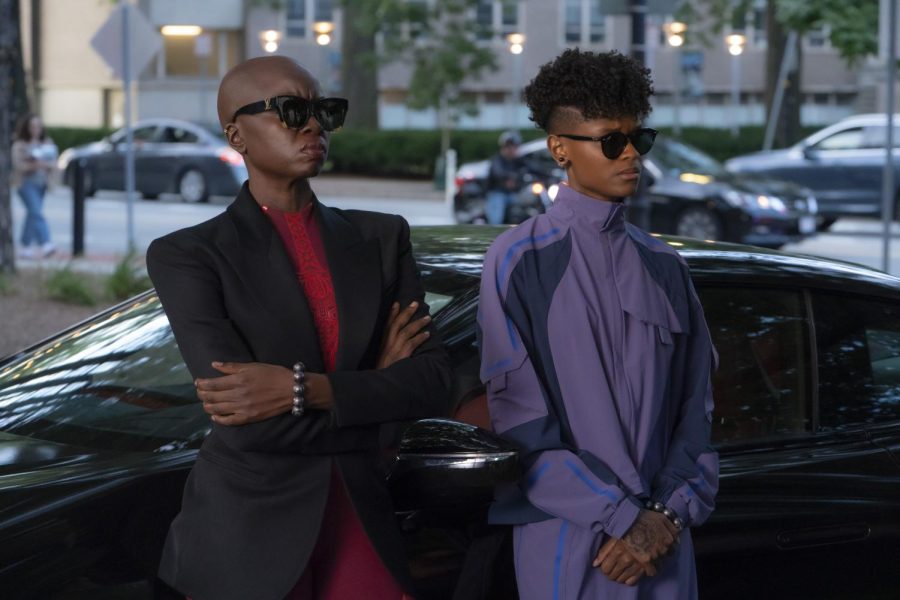‘Black Panther: Wakanda Forever,’ a touching tribute
AP
This image released by Marvel Studios shows Danai Gurira (left) and Letitia Wright as Shuri in a scene from “Black Panther: Wakanda Forever.” (Marvel Studios via AP)
November 15, 2022
Editor’s Note: This review will contain spoilers, so read with caution, or go buy tickets to your nearest theater to watch the film and come back later.
The time has come to return to Wakanda, in “Black Panther: Wakanda Forever.” In the face of a devastating real-world tragedy, the death of Chadwick Boseman, who played T’Challa, king of Wakanda and the Black Panther, the franchise returns with a touching and thoughtful tribute to Boseman’s legacy.
Rather than replacing Boseman, Marvel decided to go a different route to honor this iconic character. The company decided to pass the mantle of Black Panther to a previously established character, Shuri, played by Letitia Wright.
The story is infused with powerful emotions as the Wakandans deal with grief and loss. Both Wright and Angela Bassett, who plays Queen Ramonda, gave powerful performances. Bassett in particular truly felt like a grieving mother, and viewers could see and feel the pain she was experiencing.
Bassett’s tone and voice perfectly reflect her feeling of grief and anger after dealing with the loss of both her husband and son. At one point when she was talking in the throne room she let out her anger and frustration for the situation.
“Have I not given everything!” Ramonda said.
AN ARC OF GRIEF, SYMBOLISM AND MORE
Shuri’s arc in the movie perfectly represents the stages of grief: denial, anger, bargaining, depression and acceptance. In the beginning of the film, Shuri speaks about being angry after everything that has happened in her life and in her kingdom. She shares in a heated moment when mourning her brother that grief is strong enough to burn down the world.
As Shuri is the main character of the movie, Ryan Coogler, the director, chose to use Boseman’s death more as a way to drive the character’s emotions and reactions rather than the plot itself. It feels authentic, and lets the actors connect their real emotions with their character’s emotions.
Shuri is angry about not being able to save her brother or her mother, Queen Ramonda, when they died. She is worried for the safety of her kingdom after the events of the last “Black Panther” movie when Killmonger, the film’s antagonist played by Michael B. Jordan, burned the heart-shaped herb garden.
The herbs are an important symbol for the Wakandans as they represent strength and the blessing of their Goddess. The plants are laced with vibranium, a rare and mysterious metal said to have come from the heavens, that gives superpowers to anyone who consumes them. After getting a fragment of the plant from a previously unknown underwater kingdom, she is able to artificially recreate the herb and decides to consume it in order to gain the powers of the Black Panther.
Afterward, she sees visions of Killmonger and connects with her ancestors by tapping into the power of the Black Panther.
Coogler uses moments like this to draw parallels to the original movie. Both Shuri and Killmonger saw similar things when they gained the power of the herb. Shuri sees Killmonger in the place her mother died and Killmonger sees his father in the place where he died.
However, although Killmonger and Shuri had similar experiences, how they chose to handle their grief was very different. They both sought revenge against their parents’ killers, but Shuri was able to overcome her grief by choosing peace while Kilmonger was not. This helps Shuri grow as a character and I really appreciate that.
NEW CHARACTERS IN THE MCU
The film also saw the addition of new characters and settings that expand the world of the Marvel Cinematic Universe. The movie introduces Riri Williams or Ironheart, played by Dominique Thorne, and Namor, played by Tenoch Huerta.
In Williams’ introduction scene, we see a comical interaction between the characters when Okoye, played by Danai Gurira, and Shuri go to pick her up from her dorm room. Okoye brings out her spear and slices a Bluetooth speaker Wright throws in half, and then the woman has a comical exchange about Okoye’s looks.
Thorne gives a light-hearted and believable performance, as the dialogue feels like something a young college girl like Riri would say – maybe a bit rude, but still funny. Audiences will see Thorne again as she will be reprising her role in the upcoming Disney+ show “Ironheart.” I’m looking forward to seeing a new Ironman-like character and I hope Thorne continues the strong performance from the movie.
Another MCU character making his debut is Namor. Huerta gives a powerful performance as the king of the underwater kingdom, Talokan. Like the Wakandans, Talokans also get their power from a plant laced with vibranium. This begins the movie’s main conflict, as world powers begin to struggle for sources of vibranium, and look to the kingdoms of Wakanda and Talokan, which are rich in the metal. I really enjoyed the costumes and character design of different kingdoms and how they build a new world within the MCU.
Namor’s appearance also marks the first instance of a character openly identifying as a mutant in the MCU. This opens the door for the MCU to introduce more mutants; hopefully, this means we will get to see the X-Men soon.
I really enjoyed seeing the MCU’s interpretation of this character. The production team beautifully blended Mayan mythology and comic book lore. I also liked Huerta’s casting, as his Mexican heritage played well into his interpretation of the character. I appreciate how Marvel is being more authentic with casting choices.
Overall, this film was a phenomenal end to the current saga of Marvel movies and I’m looking forward to seeing what comes next for the franchise.







